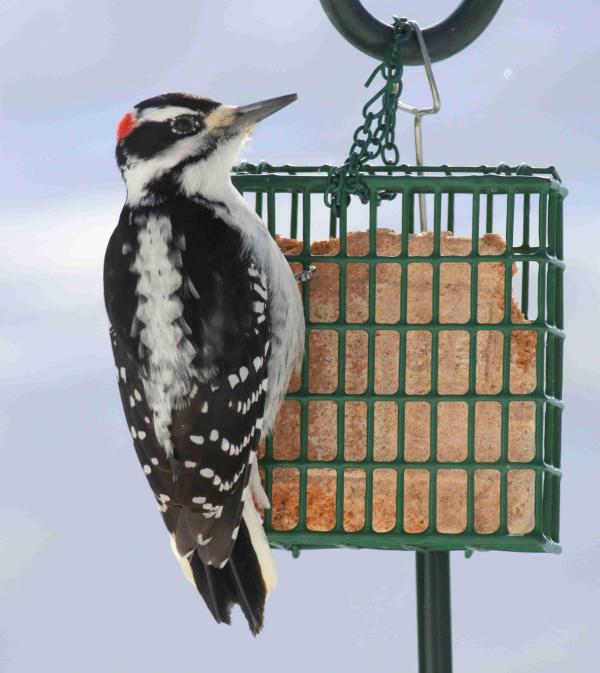

Why do we find feeding wild birds so enjoyable? Does feeding help birds? Did you know that by the 1890s feeding birds was a popular activity across much of the United States? A recent discussion about one of America’s favorite outdoor activities — feeding and observing birds in our yards — provided some interesting insights and more than a few thoughts for further consideration. It’s a desire, if not a need, to connect with the outdoors, with nature and with other living creatures. Feeding birds allows people to do that in a really easy way.
That’s the take provided by Emma Greig in the recent article “Why Do We Feed Birds — and Should We,” which was published in The Living Bird, the quarterly publication of the Cornell Lab of Ornithology. Greig, the project leader for Project FeederWatch, was interviewed, along with Darryl Jones, author of the book, The Birds at My Table.
Jones added that people who feed birds want to learn about birds and feeding them brings some species up close. That leads to this whole area where interacting with nature can lead to increased psychological, physical and spiritual well-being. If that’s the case, bird feeding is one of the most intimate, immediate kinds of interactions with nature that we can have.
Regarding the benefit to birds, Jones noted: There are many examples of how birds are benefiting from feeding. There is no question that they are more likely to survive winter if they get fed. Greig added that the way to think about bird feeding is really that it’s a supplement. Studies show that feeding birds increases their survival during particularly harsh conditions.
Emma Greig continued that one thing that has been documented in some feeder species, is a super interesting pattern that their ranges are expanding north. We’re seeing this in birds like Red-bellied Woodpeckers, Carolina Wrens, Anna’s Hummingbirds and Northern Cardinals. They are starting to range in places where they didn’t occur before and they’re moving into colder locations. It’s very possible that supplementary feeding has something to do with that.
How big is the bird feeding industry? According to the book, Feeding Wild Birds in America, the market for bird foods was $4 billion in the United States, with almost another billion ($970 million) spent on feeders and other accessories. That information was from 2012, and those numbers are higher today, due to a steady increase in birders who feed birds.
Darryl Jones shared the sentiment that bird feeding is a noble activity – we just need to do it with the birds in mind. Most of our motivation is human motivation; we want to feel good about it. That’s fine, as long as we also do it with the birds’ well-being in mind. We must be responsible for what we’re doing as we continue to enjoy feeding birds.
When asked about any problems that bird feeding could lead to, Greig answered that some of the potential cons included 1) transmission of disease among birds, because you have many animals coming to one place. 2) There may be an increased threat of predation to feeder birds, again because you have these potential prey species coming to one location, and a raptor may find a feeding station to be a periodic hunting site. 3) People who have pet cats can create a predation problem around feeders too. 4) Plus, bird feeding often takes place near houses so there’s an increased potential for birds to collide with windows.
She summed those thoughts by adding that we must keep our feeders and feeding areas clean, offer quality bird foods, keep cats indoors, and position feeders a safe distance from windows. These are very simple steps that anyone who feeds birds should be taking.
Overall, the more birders who are paying attention to what birds are doing in their yards and participating in Project FeederWatch and The Great Backyard Bird Count, the better. In that way, we monitor birds during the winter season and understand when and how things are changing over time.
It is interesting to note that this article sparked considerable discussion and input from hundreds of readers who thought the article was very good, although a few noted that it left out a few important points, and that it over-emphasized a few concerns. You should definitely take a look at some of the remarks by fellow birders to get a feel for their input, which is a story in itself.
A nice takeaway from the article sums bird feeding up for many birders: Feeding birds is a way of inviting unexpected natural beauty into your yard, every day.
For the entire discussion about feeding birds, published in the Winter 2019 issue of The Living Bird, see
https://www.allaboutbirds.org/why-do-we-feed-birds-and-should-we-a-qa-with-the-experts/?__hstc=161696355.bace37684fffb308f42a351c5acbbd14.1548789149785.1549398340299.1549636946347.8&__hssc=161696355.3.1549636946347&__hsfp=3606694521#_ga=2.237321152.1992411431.1549636945-2062705133.1548886370 and be sure to read through some of the extended discussion by article readers and fellow birders!










